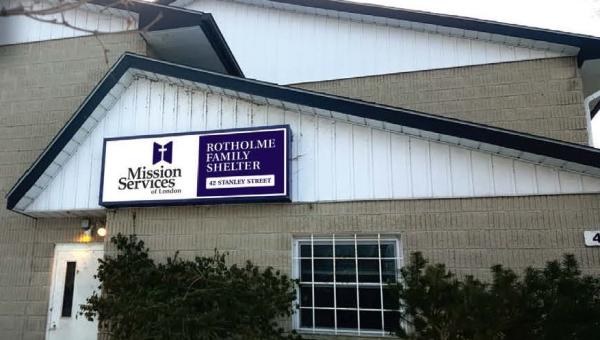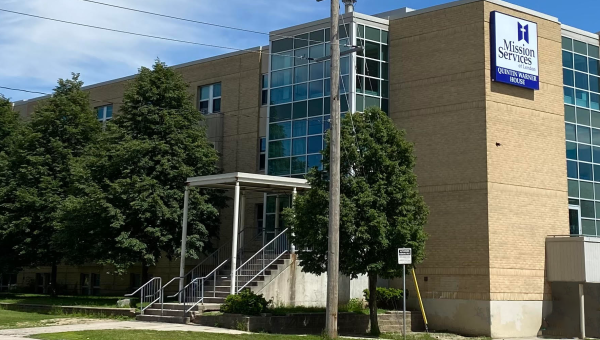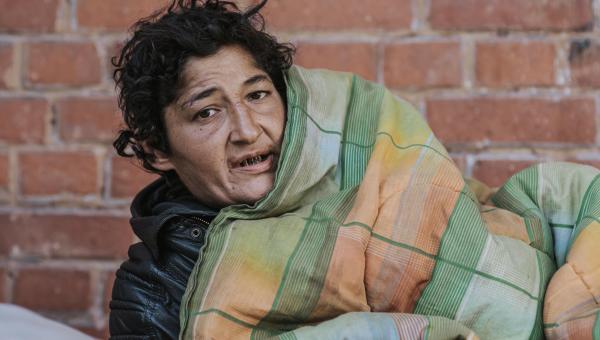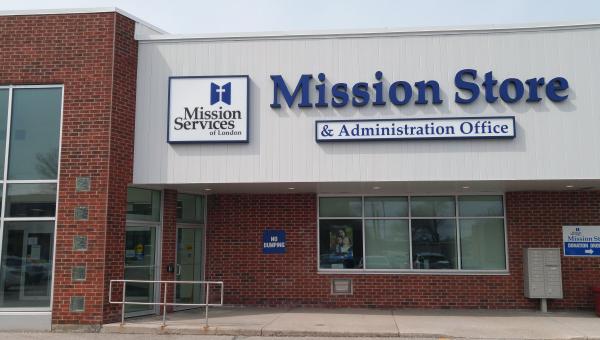Our History
Mission Services of London's story begins in 1949, when a group of Mennonite men visited downtown London to assess the local need of men experiencing homelessness.
From early days, London had grown and prospered, building a strong manufacturing base and developing a financial and insurance centre bolstering a diversified industrial base. By mid-twentieth century, when the city was preparing for expansion, these Mennonite leaders were considering the feasibility of establishing a small shelter for men experiencing homelessness in London.
- Men's Mission
Some readers of the London Free Press in late January 1951 may have noted a very small ad announcing that an emergency shelter for men was opening on January 29. The shelter was called Goodwill Rescue Mission, and was located at 536 Talbot Street in London, Ontario. This would be the beginning of the Men's Mission, as we know it today.
536 Talbot Street was a 20-room duplex, and was purchased through the profits of a cash crop grown specifically for the purpose of funding the emergency shelter's start-up. It was a duplex, where one half served as a residence for the founding Executive Director, Alvin Roth, his wife, Madeline Roth, and their children, while the other half was used for the Mission itself.
On January 29, 1951, Goodwill Rescue Mission opened their door at noon and served a meal to nine men. The same night, six men slept at the Mission. In the first four weeks of operation, 631 meals were served and 350 nights of shelter were provided.
By 1954, the Mission was serving as many as 60 men some days. The need and the Mission started garnering the attention of the then United Community Chest (UCC) and the London Police Department. Through UCC, the Goodwill Rescue Mission became eligible to receive financial aid.The Goodwill Rescue Mission grew quickly. In 1956, the Mission was given a grant to finance some necessary renovations to make room for a larger number of men and moved the Roth family into their own private dwelling.
In the following year, 1957, the named 'London' replaced 'Goodwill' in the title of the Mission; and it officially became the 'London Rescue Mission.' Concurrently, a new dimension was added to the work: rehabilitation and recovery. A new facility was needed for this purpose, and once again, God answered prayers.
A property in Wallacetown, approximately 48 km southeast from London, was offered at a token price. Originally called '11th Step House', it had been used by Alcoholics Anonymous as a retreat centre. In June 1957, the Mission acquired this property, renamed it 'Bethel House' and operated it as a rehabilitation arm of the London Rescue Mission. Bethel House would be the starting roots of Quintin Warner House, as we know it today.
In 1961, the London Rescue Mission got the go-ahead to build a new and larger shelter site - this time, at 459 York Street in London, Ontario. On September 17, 1961, the new building was officially opened. Included were 80 beds, a comfortable TV lounge which also served as the Chapel, an activities room for games and recreation, a small library, a counselling room, and admissions office, and administrative office space. In the basement, which had windows at ground level, a modern kitchen served a large dining room for the men staying there. Laundry rooms, shower and washroom facilities, and storage space was also included. This new building became the Men's Mission.
Men's Mission continued to grow, meeting need at the point of need. Programs were expanding and new needs were identified, and more arms of Mission Services of London were surfacing to meet those needs.
Many donors, churches, and funders have come alongside Mission Services of London to support the Men's Mission.
- Rotholme Family Shelter
Work with women began early in the history of the Goodwill Rescue Mission, which opened on January 29, 1951. Frequently, women in need came to the Mission for help. While they were not turned away, it became clean that a new place had to be found to focus on support for women.
In 1956, a property became available at 668 King Street, and the first Executive Director, Alvin Roth, personally purchase the property. The house needed a lot of renovation, but there were several beds available for women, an apartment for the workers, and several light housekeeping rooms. This location was known as the Women's Division.
In the month of June 1956, 300 nights of shelter were provided and 900 meals were provided.
The women's shelter was relocated in 1962 to a three-story, 17-bed capacity house at 163 Clarence Street, which was purchased as temporary facility. This building was known as the Women's Mission.
The Women's Mission provided a bed, meals, and clothing as it was available. This was a temporary home for women who were in need. It was a close-knit family style of living, with all participants assuming some responsibility for housekeeping duties. A rehabilitation program provided the participants with meaningful relationships through interaction with other participants and staff.
Mission Services of London began focusing on family work following the formation of the WA in 1960. Crisis assistance to families, a very important service offered by the London Rescue Mission, was undertaken and organized in 1961 by the WA, and operated with the assistance of the Mission secretarial staff. Family work was a combination of emergency services, which included food, clothing and furniture, and later shelter. This work was carried out by the Men's Mission.
In October 1969, the Women's Mission officially became a separate branch of Mission Services of London and was renamed "Women's Mission and Rehabilitation Residence."
This branch continued on at 163 Clarence Street until 1975, when it was turned into an experimental recovery home offering detoxification and recovery programs to women suffering from substance addiction. 163 Clarence Street was then again renamed "Rotholme," in recognition of Alvin Roth's outstanding service to Mission Services of London.
At that time, the Women's Mission and Rehabilitation Residence moved to another location, until a study was done by a committee appointed by the City of London, and the experiment was terminated. These two groups of women were integrated again back at Rotholme.
In 1973, the family assistance that the WA was supporting officially became recognized as a branch, and was called the Family Centre. Ideas started stirring to combine the emergency family shelter and Rotholme at the same site.
In 1975, a Branch Director was appointed for the Family Centre, and the WA began focusing their efforts elsewhere.
In 1978, 42 Stanley Street, where Rotholme Family Shelter is still located today, was purchased and the Family Centre and Rotholme were combined. 42 Stanley Street became Rotholme Women's and Family Shelter, was overseen under one directorship, and served both families and single women experiencing homelessness.
Since then, Rotholme Family Shelter now solely focuses on serving families at risk of or experiencing homelessness.
- Quintin Warner House
The work at Quintin Warner House actually began outside the City in 1957.
The Men's Mission was very crowded in it's early days, and each participant had individual goals for themselves.
For men staying at the Men's Mission who were looking for recovery and rehabilitation, another site would be most beneficial as they would be with like-minded individuals who shared their current goals.
A property in Wallacetown, Ontario was offered to Mission Services of London at a token price. In June 1957, Mission Services of London acquired this property, named it "Bethel House," and operated it as a rehabilitation arm of Men's Mission (named "Goodwill Rescue Mission" at the time).
Bethel House received much support and guidance from two local men. One was Canon Quintin Warner, an Anglican Clergyman, who was largely responsible for bringing the Alcoholics Anonymous movement into Canada, and for organizing the first group in London. The other was Dr. Charles Aharan, a psychologist who was Director of the area branch of the Addiction Research Foundation (ARF), a very vocal advocate of treating people suffering from addiction rather than incarcerating them.
The results of Bethel House during its first seven years of operation was encouraging. But the distance from London was challenging. On April 1, 1965, a large house at 477 Queens Avenue was purchased with the intention of continuing the good work that was started by Quintin Warner and his associates.
477 Queens Avenue continued serving as Quintin Warner House's main location until 2023, when the program was expanded and relocated. Today, 477 Queens Avenue is a Quintin Warner House Annex for graduates of the addiction treatment program.
Still an extension of Men's Mission, Quintin Warner House (renamed from "Bethel House," after Quintin Warner) was struggling to facilitate programming for men in recovery. Dr. Charles Aharan, at no cost to Mission Services of London, loaned a member of his ARF staff, Art Young, to develop and conduct a full scale program. Art, a Master of Social Work, with extensive experience in the addiction field, laid the foundation for one of the most successful alcoholism recovery programs to be found anywhere. During the 2.5 years he spent at Quintin Warner House, not only did he achieve remarkable results, he so endeared himself to the men he worked with that some of them actually shed tears when he left.
In January 1973, Quintin Warner House, approved for provincial funding, was separated from the Men's Mission and recognized as a separate branch.
Although there was a continual trend towards men completing the program and maintaining sobriety for long periods of time, it was also apparent that the transition from Quintin Warner House back into the community was difficult. In solution, Quintin Warner House opened its first Annex.
With this objective, in March 1976, a large house at 497 Maitland Street, just half a block from Quintin Warner House, was purchased. It housed graduates for up to a year while they attended classes to upgrade their skills, sought employment, or worked.
Today, Quintin Warner House operated out of 457 York Street and continues to be a four-month, live-in addiction treatment centre for men. Quintin Warner House continues their transitional programming through After Care and the Annexes once participants graduate.
- Community Mental Health Programs
Community Mental Health Programs (CMHP) is a team of Mission Services of London since 1985. CMHP is funded in partnership with Ontario Health.
CMHP was established to support individuals living with, or experiencing symptoms of serious mental illness, concurrent disorders, and other complex needs.
Programs were initially created to focus solely on individuals who experience chronic homelessness; although CMHP no longer carries this specific focus.
- The Mission Store
The Women’s Auxiliary to Mission Services of London started the Clothing Centre in 1964, which would eventually develop into the Mission Store as we know it today.
At the start, the Clothing Centre operated out of the Men's Mission. In the first year of offering services, the Clothing Centre distributed 28,352 articles of clothing for no cost (not including hats, shoes, handbags, and other miscellaneous accessories).
On September 29, 1966, the Women’s Auxiliary announced their purchase of 461 York Street for $18,000, and used the ground floor as the Clothing Centre.
The Clothing Centre operated using a voucher system, wherein vouchers were exchanged for free garments that the shopper could choose themselves. The Mission Store continues this program today, offering basic-needs items to thousands of individuals through the Emergency Voucher Program.
The need for clothing continued to grow, and the Mission Store grew in response. The Mission Store changed names (from the Clothing Store, to Used Clothing Store, to Twice Nice Thrift Mart, to Mission Store), and locations, although always within walking distance from Men's Mission.

Rotholme Family Shelter

Quintin Warner House

Community Mental Health Programs

Mission Store
How You Can Help
Your support makes a difference. Whether through donations, volunteering, or spreading awareness, there are many ways to contribute to providing a lifeline to those in need.
Thank you for your interest in Mission Services of London. Together, we can be a pillar for our neighbours in need to lean on.
For more information or to seek assistance, please visit our Contact Us page.


